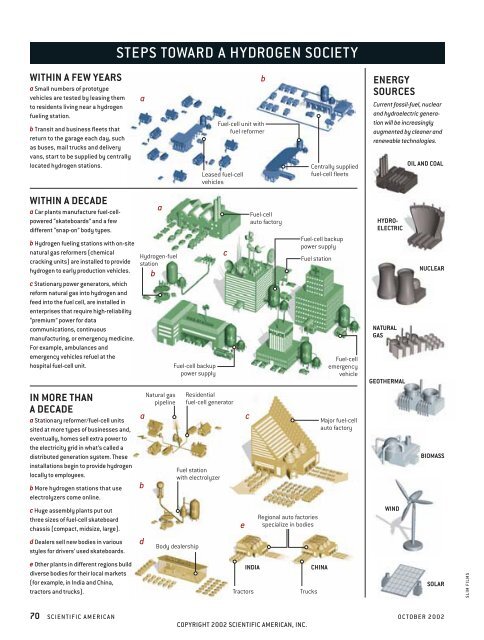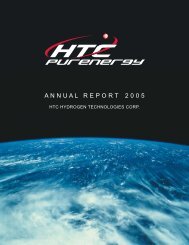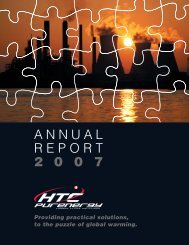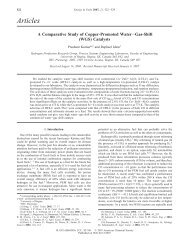Scientific American.pdf
Scientific American.pdf
Scientific American.pdf
Create successful ePaper yourself
Turn your PDF publications into a flip-book with our unique Google optimized e-Paper software.
STEPS TOWARD A HYDROGEN SOCIETY<br />
WITHIN A FEW YEARS<br />
a Small numbers of prototype<br />
vehicles are tested by leasing them<br />
to residents living near a hydrogen<br />
fueling station.<br />
b Transit and business fleets that<br />
return to the garage each day, such<br />
as buses, mail trucks and delivery<br />
vans, start to be supplied by centrally<br />
located hydrogen stations.<br />
a<br />
b<br />
Fuel-cell unit with<br />
fuel reformer<br />
Leased fuel-cell<br />
vehicles<br />
Centrally supplied<br />
fuel-cell fleets<br />
ENERGY<br />
SOURCES<br />
Current fossil-fuel, nuclear<br />
and hydroelectric generation<br />
will be increasingly<br />
augmented by cleaner and<br />
renewable technologies.<br />
OIL AND COAL<br />
WITHIN A DECADE<br />
a Car plants manufacture fuel-cellpowered<br />
“skateboards” and a few<br />
different “snap-on” body types.<br />
b Hydrogen fueling stations with on-site<br />
natural gas reformers (chemical<br />
cracking units) are installed to provide<br />
hydrogen to early production vehicles.<br />
c Stationary power generators, which<br />
reform natural gas into hydrogen and<br />
feed into the fuel cell, are installed in<br />
enterprises that require high-reliability<br />
“premium” power for data<br />
communications, continuous<br />
manufacturing, or emergency medicine.<br />
For example, ambulances and<br />
emergency vehicles refuel at the<br />
hospital fuel-cell unit.<br />
b<br />
b<br />
a<br />
Hydrogen-fuel<br />
station<br />
Fuel-cell backup<br />
power supply<br />
c<br />
Fuel-cell<br />
auto factory<br />
Fuel-cell backup<br />
power supply<br />
Fuel station<br />
Fuel-cell<br />
emergency<br />
vehicle<br />
HYDRO-<br />
ELECTRIC<br />
NATURAL<br />
GAS<br />
GEOTHERMAL<br />
NUCLEAR<br />
IN MORE THAN<br />
A DECADE<br />
a Stationary reformer/fuel-cell units<br />
sited at more types of businesses and,<br />
eventually, homes sell extra power to<br />
the electricity grid in what’s called a<br />
distributed generation system. These<br />
installations begin to provide hydrogen<br />
locally to employees.<br />
b More hydrogen stations that use<br />
electrolyzers come online.<br />
c Huge assembly plants put out<br />
three sizes of fuel-cell skateboard<br />
chassis (compact, midsize, large).<br />
d Dealers sell new bodies in various<br />
styles for drivers’ used skateboards.<br />
a<br />
b<br />
d<br />
Natural gas<br />
pipeline<br />
Body dealership<br />
Residential<br />
fuel-cell generator<br />
Fuel station<br />
with electrolyzer<br />
e<br />
c<br />
Regional auto factories<br />
specialize in bodies<br />
Major fuel-cell<br />
auto factory<br />
WIND<br />
BIOMASS<br />
e Other plants in different regions build<br />
diverse bodies for their local markets<br />
(for example, in India and China,<br />
tractors and trucks).<br />
INDIA<br />
Tractors<br />
Trucks<br />
CHINA<br />
SOLAR<br />
SLIM FILMS<br />
70 SCIENTIFIC AMERICAN OCTOBER 2002<br />
COPYRIGHT 2002 SCIENTIFIC AMERICAN, INC.






